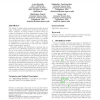Free Online Productivity Tools
i2Speak
i2Symbol
i2OCR
iTex2Img
iWeb2Print
iWeb2Shot
i2Type
iPdf2Split
iPdf2Merge
i2Bopomofo
i2Arabic
i2Style
i2Image
i2PDF
iLatex2Rtf
Sci2ools
EMSOFT
2007
Springer
2007
Springer
A dynamic scheduling approach to designing flexible safety-critical systems
The design of safety-critical systems has typically adopted static techniques to simplify error detection and fault tolerance. However, economic pressure to reduce costs is exposing the limitations of those techniques in terms of efficiency in the use of system resources. In some industrial domains, such as the automotive, this pressure is too high, and other approaches to safety must be found, e.g., capable of providing some kind of fault tolerance but with graceful degradation to lower costs, or also capable of adapting to instantaneous requirements to better use the computational/communication resources. This paper analyses the development of systems that exhibit such level of flexibility, allowing the system configuration to evolve within a well-defined space. Two options are possible, one starting from the typical static approach but introducing choice points that are evaluated only at runtime, and another one starting from an open systems approach but delimiting the space of ...
| Added | 07 Jun 2010 |
| Updated | 07 Jun 2010 |
| Type | Conference |
| Year | 2007 |
| Where | EMSOFT |
| Authors | Luís Almeida, Sebastian Fischmeister, Madhukar Anand, Insup Lee |
Comments (0)

